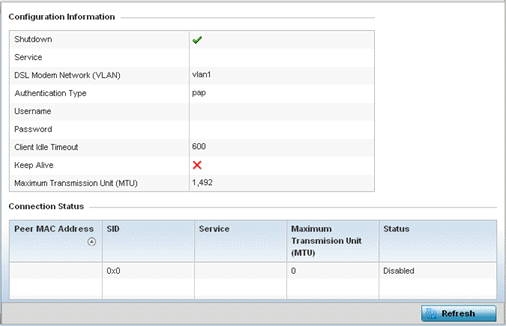The PPPoE statistics screen displays stats derived from an access point's access to high-speed data and broadband networks. PPPoE uses standard encryption, authentication, and compression methods as specified by the PPPoE protocol. PPPoE enables access points to establish a point-to-point connection to an ISP over an existing Ethernet interface.

Note
The WiNG 7.1 release does not support PPPoE on AP505 and AP510 model access points. This feature will be supported in future releases.To review a selected access point's PPPoE statistics:

| Shutdown |
Displays whether a high speed client mode point-to-point connection has been enabled using the PPPoE protocol. |
| Service |
Lists the 128 character maximum PPPoE client service name provided by the service provider. |
| DSL Modem Network (VLAN) |
Displays the PPPoE VLAN (client local network) connected to the DSL modem. This is the local network connected to DSL modem. |
| Authentication Type |
Lists authentication type used by the PPPoE client whose credentials must be shared by its peer access point. Supported authentication options include None, PAP,CHAP, MSCHAP, and MSCHAP-v2. |
| Username |
Displays the 64 character maximum username used for authentication support by the PPPoE client. |
| Password |
Displays the 64 character maximum password used for authentication by the PPPoE client. |
| Client Idle Timeout |
The access point uses the listed timeout so it does not sit idle waiting for input from the PPPoE client and the server, that may never come. |
| Keep Alive |
If a keep alive is utilized, the point-to-point connect to the PPPoE client is continuously maintained and not timed out. |
| Maximum Transmission Unit (MTU) |
Displays the PPPoE client maximum transmission unit (MTU) from 500 - 1,492. The MTU is the largest physical packet size in bytes a network can transmit. Any messages larger than the MTU are divided into smaller packets before being sent. A PPPoE client should be able to maintain its point-to-point connection for this defined MTU size. |
Refer to the Connection Status field.
The Connection Status table lists the MAC address, SID, Service information MTU and status of each route destination peer. To provide this point-to-point connection, each PPPoE session learns the Ethernet address of a remote PPPoE client, and establishes a session. PPPoE uses both a discover and session phase to identify a client and establish a point-to-point connection. By using such a connection, a Wireless WAN failover is available to maintain seamless network access if the access point's wired WAN were to fail.